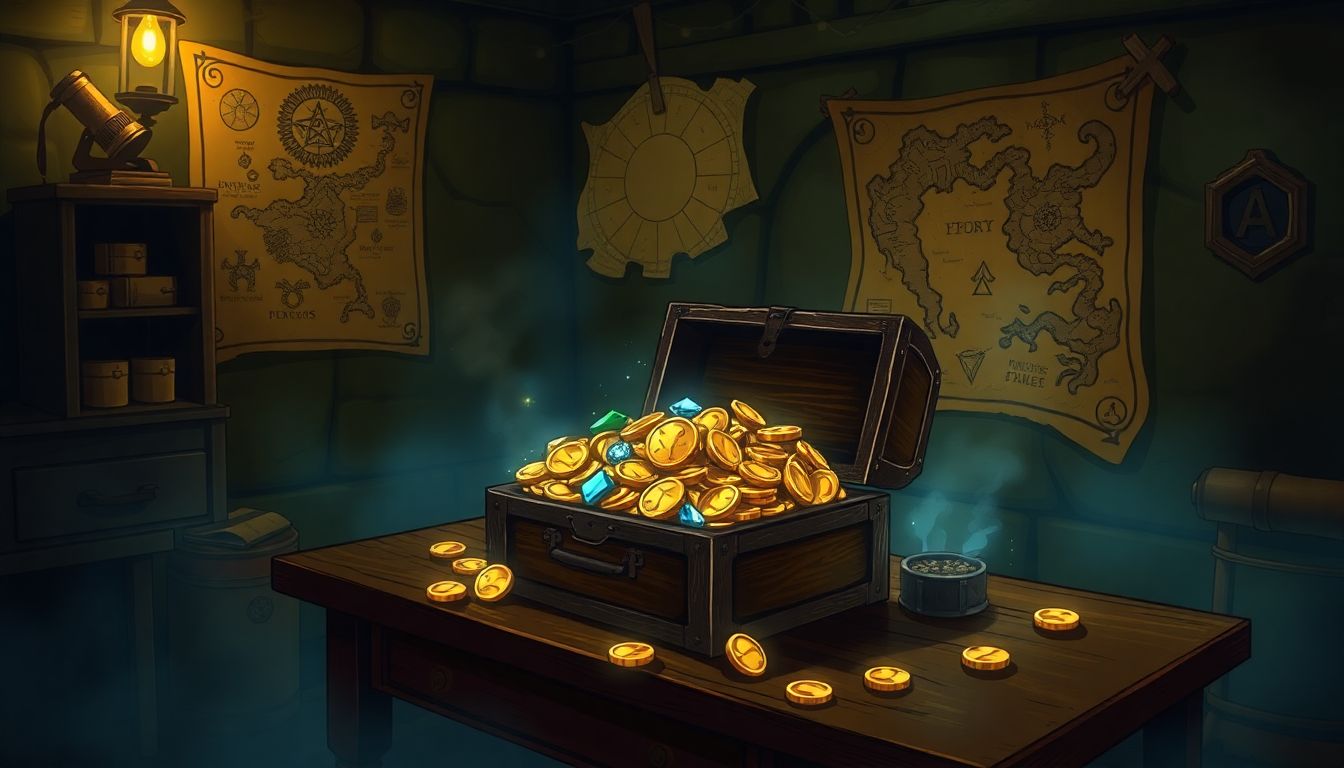Are you scratching your head trying to come up with fun and engaging prompts for an escape room? It can feel overwhelming to create the perfect adventure that keeps players on their toes and guessing every step of the way. You’re definitely not alone in this dilemma!
But what if I told you that there’s a treasure trove of ideas waiting just for you? If you stick around, you’ll discover creative prompts and unique themes that can transform any escape room experience into something memorable and exciting.
From clever puzzles to captivating narratives, this guide will equip you with everything you need to unleash your imagination. Let’s dive in and escape the ordinary together!
Key Takeaways
Key Takeaways
- Use creative prompts to design engaging escape room scenarios, like haunted mansions and time travel adventures.
- For virtual rooms, consider themes like detective mysteries or alien invasions to enhance online interaction.
- Unique themes, such as steampunk or horror, can significantly improve player immersion and enjoyment.
- Customize puzzles based on group experience levels to keep all participants engaged and challenged.
- Create a strong narrative and use props and music to enhance the atmosphere of your escape room.
- Incorporate teamwork elements and provide hints to maintain player engagement and prevent frustration.

Best ChatGPT Prompts for Escape Room Scenarios
Using ChatGPT to generate escape room scenarios can be a game-changer for your next event.
Here are some prompts you can use right away:
- Create a thrilling escape room scenario set in a haunted mansion.
- Generate a mystery puzzle where players must decode a secret message left by a spy.
- Design an adventure that takes place on a spaceship in need of repairs to escape before running out of oxygen.
- Outline a time-travel escape room where participants must solve historical puzzles before returning to the present.
- Formulate clues for a treasure hunt within a pirate-themed escape room.
These prompts can help you create engaging and immersive experiences that will captivate players.
Creative Scenarios for Virtual Escape Rooms
Virtual escape rooms are becoming more popular, especially for remote teams.
To keep the excitement alive in a digital realm, consider these creative scenarios:
- A detective mystery where players must solve a virtual crime by examining online clues.
- A virtual art heist where participants navigate through a digital gallery to recover stolen masterpieces.
- An alien invasion scenario where players must find a way to communicate with extraterrestrials to save humanity.
- A cursed island adventure where participants must uncover the mysteries of an ancient civilization while racing against time.
These scenarios not only engage players but also promote teamwork in an online setting.
Unique Themes for Escape Room Challenges
The theme can make or break your escape room experience, so thinking outside the box is essential.
Here are some unique theme ideas to consider:
- A steampunk universe where players navigate using gadgets and machinery.
- A horror theme set in an abandoned asylum where players must uncover the dark history through clues.
- A fantasy realm where participants must team up with mythical creatures to solve puzzles and escape a sorcerer’s trap.
- A retro video game theme, where players solve challenges reminiscent of classic 8-bit games to progress.
Choosing the right theme helps enhance immersion and keeps participants engaged.
Instructions for Implementing Escape Room Prompts
Implementing prompts for escape rooms requires some organization and creativity. Here’s a quick guide:
1. Define the scope: Determine whether your scenario is physical or virtual to tailor your prompts accordingly.
2. Set the mood: Create a backstory or narrative that aligns with your chosen theme.
3. Generate puzzles: Use specific ChatGPT prompts to create puzzles that align with your theme, such as:
- “Create a mechanical puzzle that represents a steampunk device.”
- “Design a riddle to unlock a digital door in a virtual escape room.”
4. Test the experience: Run through your escape room scenario to ensure clues and puzzles flow smoothly.
5. Gather feedback: After the event, ask players for their thoughts to improve future escape room setups.

How to Customize ChatGPT Prompts for Your Escape Room
Customizing ChatGPT prompts is key to making your escape room experience unique and tailored to your group’s interests.
Start by understanding your audience; are they experienced escape room veterans or first-timers?
Use this information to tailor the difficulty level of your challenges.
Here are some prompts you can immediately use:
- “Customize a puzzle for a group of beginners that involves simple math and observation.”
- “Create a mystery involving themes of espionage specifically catered to a team of corporate colleagues.”
- “Generate a series of clues for a horror-themed escape room aimed at an adult audience.”
- “Develop trivia questions about pop culture for a virtual escape room designed for young adults.”
Encourage player input by asking them about their preferences beforehand.
This allows you to create a more immersive story that keeps everyone engaged.
Examples of Puzzles and Clues to Use with ChatGPT
Puzzles and clues are the backbone of any escape room, and ChatGPT can help you craft them in seconds.
Below are examples of puzzles that you can use directly with ChatGPT:
- “Create a crossword puzzle that reveals a secret code when completed.”
- “Generate a series of hidden messages scattered throughout a story that players need to piece together.”
- “Design a logic puzzle involving different colored keys and doors for players to solve.”
- “Formulate a scavenger hunt list for a virtual escape room that includes digital items to find online.”
Each puzzle type can cater to a different skill set, making it easier to engage all your players.
For example, consider using riddles for teams that enjoy wordplay, while logic puzzles might appeal to more analytical minds.
Don’t forget to test these puzzles in advance; you want them to be challenging but not impossible!
Tips for Engaging Players in Escape Room Experiences
Engaging players in an escape room requires a mix of storytelling, teamwork, and fun.
First, create a compelling narrative that draws players into the experience.
Here are some actionable tips to keep players engaged:
- Set the stage with atmospheric music and props that align with your theme.
- Encourage teamwork by assigning specific roles to players, such as a leader or a puzzle solver.
- Provide hints or lifelines periodically to avoid frustration and keep the momentum going.
- Incorporate time limits to add urgency, but ensure they’re generous enough to allow for exploration.
At the end of the game, consider holding a debriefing session where players can share their favorite moments.
This not only fosters camaraderie but also gives you valuable feedback for future events.

Conclusion: Enhancing Your Escape Room with ChatGPT
Incorporating ChatGPT into your escape room design can significantly elevate the experience.
With its ability to generate unique scenarios, puzzles, and engaging narratives, ChatGPT becomes a valuable ally.
To effectively enhance your escape rooms using AI, start by experimenting with various prompts.
Test different themes and scenarios to discover what resonates best with your players.
After every event, gather feedback from participants to refine your prompts and improve future experiences.
Consider asking questions like:
- “What element of the escape room did you enjoy the most?”
- “Were the puzzles challenging yet solvable?”
This feedback loop helps you craft even more immersive experiences.
Ultimately, the goal is to create unforgettable moments for players, making each escape room adventure a new and exciting journey.
So, go ahead and let ChatGPT help you unlock the full potential of your escape room ideas!
FAQs
Engaging themes for escape rooms include mystery, adventure, horror, and science fiction. Each theme can incorporate unique settings, storylines, and puzzles to enhance player immersion and challenge their problem-solving skills.
To customize ChatGPT prompts, consider your theme and storyline. Tailor the prompts to include specific clues, characters, and settings relevant to your escape room, ensuring they align with the challenges you want the players to tackle.
Puzzles such as riddles, logic games, and digital clue hunts work well with ChatGPT. Incorporate variations like code-breaking or pattern recognition to diversify experiences and keep players engaged throughout the escape room.
To keep players engaged, create immersive scenarios, offer varied clues, and encourage teamwork. Provide hints when players seem stuck and maintain a good pace to ensure excitement and challenge throughout the escape room experience.
